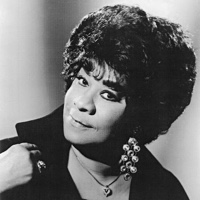Home » Jazz Musicians » Ruth Brown
Ruth Brown
“Miss Rhythm”
Years before Aretha Franklin was crowned Queen of Soul, Ruth Brown reigned as the Original Queen of R&B. She achieved a distinct style, sassy and streetwise, which made her one of the more influential singers of her era. Ms. Brown sustained a career for six decades: first as a bright, bluesy singer who was called “the girl with a tear in her voice” and then, after some lean years, as the embodiment of an earthy, indomitable black woman. She had a life of hard work, hard luck, determination, audacity and style. Sometimes it was said that R&B stood as much for Ruth Brown as it did for rhythm and blues.
Ruth Brown was born Ruth Weston in Portsmouth, Virginia on January 12, 1928. Ruth began to sing at the local AME church where her father was the choir director. Her influences were Billie Holiday, Sarah Vaughan, and Dinah Washington. In 1945 she ran away with singer/trumpeter Jimmy Brown and they wed soon after.
The big-band leader Lucky Millinder heard her in Detroit late in 1946, hired her for his band and fired her in Washington, D.C. Stranded, she managed to find a club engagement at the Crystal Caverns. There, the disc jockey recommended her to friends at Atlantic Records. On the way to New York City, however, she was seriously injured in an automobile accident and hospitalized for most of a year; her legs, which were smashed, would be painful for the rest of her life. She stood on crutches in 1949 to record her first session for Atlantic, and the bluesy ballad “So Long” became a hit.
Throughout the 1950s, Ruth Brown churned out dozens of R&B hits, including her million-selling “Mama, He Treats Your Daughter Mean,” “5-10-15 Hours,” “Mambo Baby,” and “Teardrops From My Eyes.” Brown's two dozen hit records helped Atlantic Records secure its footing in the record industry, a track record for which the label was referred to as 'the House That Ruth Built'. She later crossed over into rock'n'roll with "Lucky Lips" and "This Little Girl's Gone Rockin'," a song she co-wrote with Bobby Darin.
Her hits ended soon after the 1960s began, after two- dozen R&B chart appearances for Atlantic that streak ended with "Don't Deceive Me." She lived on Long Island, raised her sons, worked as a teacher’s aide and a maid and was married for three years to a police officer. On weekends she sang club dates in the New York area, and she recorded an album in 1968 with the Thad Jones- Mel Lewis Big Band. Although her hits had supported Atlantic Records, she was unable at one point to afford a home telephone. She decided to lay low and slipped into a dormant period.
Read moreTags
Big Long Silidin' Thing - Celebrating Melba Liston

by Mary Foster Conklin
In the first hour, we celebrate trombonist, composer and arranger Melba Liston in honor of her birthday, and take a look at some recent trombone players making noise in the jazz world. We sample some new releases by vocalists Josephine Beavers, Lila Ammons, Virginia Schenck, flutist Andrea Brachfeld and pianist Roberta Piket, with birthday shout outs to vocalists Ruth Brown (pictured), Jessica Molaskey, trombonist Audrey Ochoa, trumpeter Ingrid Jensen, pianist Kris Davis and drummer Tina Raymond, among others, plus a ...
Continue Reading






























